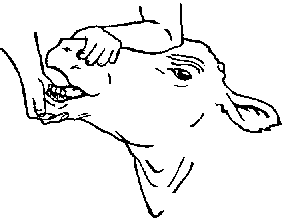Ok... Ok...Most of our herds are composed of cattle of various ages, from newborn calves to fully grown cows and oxen. Each one on those compositions differs in age.
Soo! What does teething have to do with age? Cattle have 8 temporary/baby teeth which develop during the first month of their life span after being born. This teeth will eventually disappear. As they disappear, they are replaced by permanent teeth. As cattle get older and older, the permanent teeth get worn off. Some teeth even fall off. In instances like this the animal cannot eat properly. Due to malnutrition, body condition deteriorates. Such animals can be auctioned off or slaughtered. Or if you like, you can simply change the animals diet and find strategies related to that.
Using permanent teeth, we can than determine the ages of cattle.
Open the cattle's mouth and start counting.
Permanent teeth in comparison to the milk teeth are much bigger in size. They are also darker and dirty looking in color compared to milk teeth, which are much whiter.
Figure showing how we can use teeth to determine ages of cattle
Figure showing 6 permanent teeth in a cow. Thus 30-42 months of age (2.5 years to 3.5 years)
So we do we need to know the age of our cattle?
As a farmer, you need to put your heifers on the bull at the right time. When the heifers are not too small, and when they also not too big because you want them to calve as early as possible for purpose of selling offspring. On my ranch, mother nature makes all the decisions as I do not have multiple camps for breeding seasons. Depending on the breed of cattle, I would place my heifers on the bull at 18 to 24 months (1 year 6 months to 2 years). During pregnancy, they should be able to gain the rest of the weight in order to attain a minimum of about 300-320kg.
Secondly, if you choose to market to an abattoir like meatco age matters. That's when grading is really important. The grades are A grade, AB grade and C grade. So find out more about these from meatco.
Watch the video to see what I mean exactly.
XoXo





